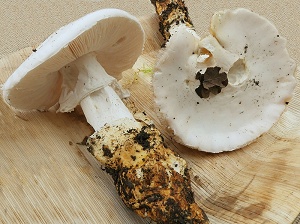| Amanita proxima Dumée |
|
|
|
|
|
|
The cap is white, slightly cream at the centre, egg-shaped then convex; its margin is smooth or with coloured veil remnants. The cap surface is smooth, not viscid nor sticky. The stem is white, with a orange-ochre to reddish-orange sheathing volva, and with a white membranous striate ring. The flesh is white, unchanging; its taste is mild; the odour is of iodine, then ripened cheese; its texture is fibrous. The gills are white, turning yellowish with age, free, crowded . The spore print is white. This species is mycorrhizal. It grows on the ground, in the woods, forest edges and paths, on a rather calcareous soil, with oak most of the time. The fruiting period takes place from July to November.
Distinctive features : ochre to reddish sheathing volva, often deeply buried in the ground; membranous and striate ring; often in southern regions on calcareous grounds; unpleasant odour Amanita proxima is still unreported so far in the forest of Rambouillet, and is quite rare, more generally speaking .
page updated on 14/01/18 |
